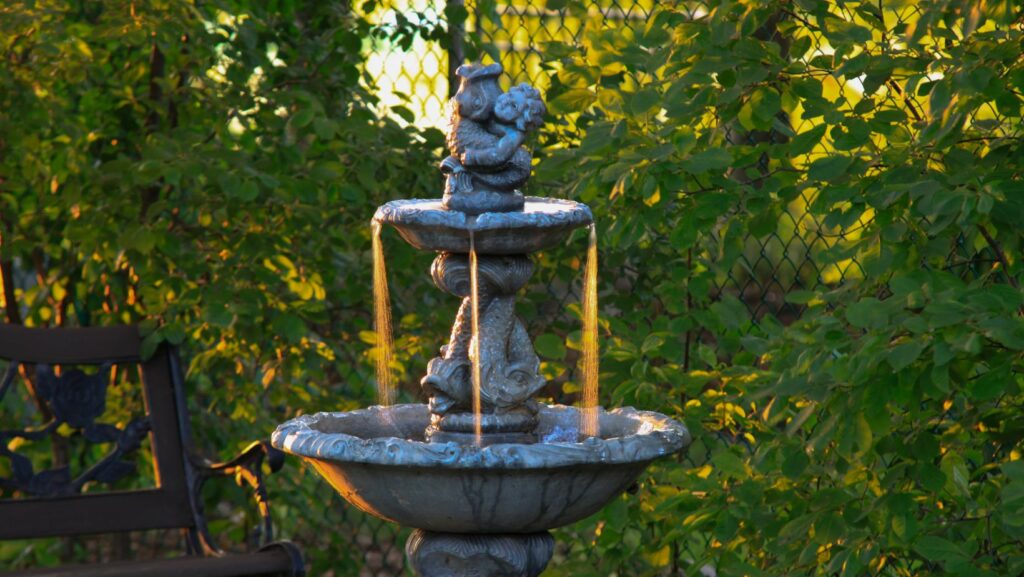If you want to add a touch of luxury to your backyard without spending a lot of money, a backyard fountain is a great option. Not only are they visually appealing, but fountains can also help create a relaxing and meditative atmosphere in your backyard.
Selecting The Right Location for Your Backyard Fountain
There are a few elements to consider when deciding on the best location for your backyard fountain. The first is the amount of sunlight the area gets. Fountains need direct sunlight to function properly, so an area that gets at least six hours of sunlight each day is ideal.

Another element to take into account is the size of the area. You want to ensure the fountain is in proportion to the space it is in. A small fountain will look out of place in a large backyard, while a large fountain in a small space will be too overwhelming.
With these things in mind, you should have no trouble finding the ideal spot for your backyard fountain!
Planning and Preparing The Area for Your Fountain
The first step to having a beautiful and peaceful backyard oasis is to plan and prepare the area for your fountain.
When choosing the location for your fountain, be sure to take into account the size and weight of the fountain, as well as any required electrical outlets. It is also important to consider the direction of the sun when placing your fountain, as you will want to avoid placing it in an area that gets direct sunlight all day long, as this can cause algae growth.
After you have selected the ideal spot for your fountain, clear away any debris, such as sticks or rocks, and level off the ground. Then, use stakes and string to mark the perimeter of where your fountain will be located.
Do it Yourself Backyard Fountains
1. To ensure a successful set-up, double-check that the pump you have is compatible with the size and type of fountain you own. All of our pumps come with a GPH (gallons per hour) rating to give you an idea of how much water your pump can move in an hour.
2. To protect yourself from electrical shock while working near water, always use a ground-fault circuit interrupter (GFCI).
3. Put your fountain where you want it before filling it with water. It’s a lot simpler to move a fountain when it doesn’t have any water in it!
4. After you have the fountain in the desired location, begin filling it with water. Make sure to leave enough space at the top for the pump and any additional features you might be using (like lights or mist makers).
5. The next step is to install the pump. Most pumps will come with instructions, so be sure to read them before continuing. Generally, you will want to place the pump in the center of the fountain for balance.
6. After the pump is installed, plug it in and turn it on! Depending on the size and type of fountain you have, you might need to tinker with the flow rate.
Maintaining Your Fountain
Your backyard fountain is an important part of your landscape, and it requires regular maintenance to keep it looking its best. Here are some tips to help you keep your fountain in top condition:
-Clean your fountain regularly with a soft cloth or brush.
-Be sure to empty and refill your fountain with fresh water on a weekly basis.
-If you notice any cracks or damage, repair them as soon as possible.
-In the winter, drain your fountain and store it indoors to prevent freezing and damage.
The first step in maintaining your fountain is to make sure the water level is always topped up. The water should be kept at least 2 inches below the rim of the fountain to prevent overflow. You should also check the water level every day to ensure it doesn’t drop too low. If the water level gets too low, the pump won’t be able to circulate the water properly and the fountain will stop working correctly.
It is important to clean your fountain regularly. Use a soft cloth or sponge to wipe away any dirt or debris that has collected on the surface of the fountain. Be sure to also clean underneath the fountain where the pump is located. It is important to remove any buildup of dirt or debris from around the pump so that it can continue to operate properly.

You should also check your fountain regularly for cracks or other damage. If you see any damage, you should fix it as soon as possible to stop further damage from happening. In some cases, you may need to replace parts of your fountain if they become too damaged to repair.
Every two weeks, you should empty your fountain and refill it with fresh water. This will help keep the water clean, free of algae, and prevent other buildups that could cause issues for your fountain. Use a gentle cleanser when cleaning your fountain so that you don’t damage the finish.
Tips for Keeping Your Fountain Clean
Although a backyard fountain can enhance the look of your yard, it also necessitates some care to stay in pristine condition. Use the following tips to keep your fountain clean:
-Clear leaves and debris from the water surface every day.
-To clean the inside of the basin, use a mild detergent and a soft brush monthly.
-Clean out the basin and refill it with fresh water every two weeks.
It’s important to inspect and clean your pump on a monthly basis. This will help keep it in good condition and prevent any issues from arising.
Tips for Preventing Algae Growth in Your Fountain
Algae can quickly become a problem in any backyard fountain if preventative measures are not taken. Use a high-quality fountain pump that is the appropriate size for your fountain to avoid algae growth. If the pump is too small, it won’t be able to circulate the water as intended and algae will have an opportunity to develop.
One way to prevent algae growth is to use a fountain treatment that contains copper. Copper is a natural algaecide and will help keep your fountain water clean and clear. Be sure to follow the manufacturer’s directions when using any type of treatment in your fountain.
In addition to using a copper treatment, you can also help prevent algae growth by ensuring your fountain has plenty of aeration. Fountain pumps that have built-in aerators are ideal, but you can also use an air stone or bubbler to aerate the water. The added oxygen will help discourage algae growth.
Finally, clean your fountain regularly to prevent algae growth. Algae can grow very quickly in dirty water, so it’s important to keep your fountain clean. You can use a soft brush and mild soap to scrub away any algae that has started to grow on the sides of the fountain. Once you’ve removed the algae, rinse the Fountain thoroughly with clean water.
Winterizing Your Fountain
It’s important to take care of your backyard fountain when the temperature starts to dip and winter arrives. If you reside in an area with harsh winters, you might have to take additional steps to make sure your fountain is sufficiently protected. Here are some suggestions for winterizing your backyard fountain:
– If possible, drain the water from your fountain and move it indoors.
If you’re unable to move your fountain indoors, cover it with a tarp or canvas to keep it shielded from the weather.
Make sure to empty and clean the pump so that it doesn’t freeze and crack over the winter.
– If you reside in an area where temperatures frequently drop below freezing, add antifreeze to the water in order to stop it from freezing and damaging the fountain.
Troubleshooting Common Issues With Backyard Fountains
Backyard fountains can be both relaxing and enjoyable. However, even the best-kept fountain may have issues from time to time. If you’re experiencing problems with your backyard fountain, here are some tips for troubleshooting common issues.
1. If your fountain isn’t pumping water, start by checking if there is anything blocking the pump. If the pump appears to be clear, then check the electrical connection to make sure it is secure.
2. If your fountain’s water flow is uneven, start by checking the water level to ensure it is filled to the appropriate height. If the water level is where it should be, then look for obstructions in the water’s flow. Sometimes, leaves or other debris can clog the fountain and cause an uneven flow.
3. If your fountain is leaking, start by examining all of the connections to ensure that they are tight and secure. If the connections seem Secure, look for cracks or holes in the base of the fountain next. Sometimes cracks can develop over time and result in leaks.
If your fountain is making odd noises, first see if anything is impeding the water’s flow. Sometimes rocks or other debris can get caught in the fountain and make noise when they hit each other. If there does not appear to be anything blocking the water, then look for loose parts or cracked components which might be causing vibrations and noise.
